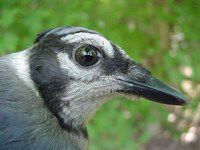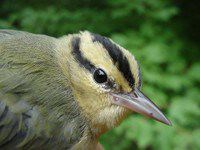|
|
|||
|
THIS WEEK at HILTON POND |

|
Katydid . . . Katydidn't With the impending arrival of autumn, insect activity is already slowing at Hilton Pond Center, but some species of six-leggers are still going strong. Mosquitoes maintain their resolve to suck our blood as we check our mist nets for birds, moths flutter around the porch light each evening, and the grigs continue to provide a sonic backdrop at various hours of the day or night. "Grigs" is an archaic European term recently resurrected by entomologists to encompass insects that "sing"--including crickets, cicadas, and katydids. Here in the Carolinas, cicadas have pretty much run their course for the year and will overwinter as larvae in the soil; Crickets sing both day or night in summer and fall--or even in mid-winter if you're lucky enough to have one chirping from the warmth of your indoor hearth. And katydids, with their alternating accusations and denials of "katydid . . . katydidn't" create so much noise on midsummer nights that their din makes our Carolina Piedmont sound like something out of Africa. Although grigs, by definition, all make songs as sexual signals, they aren't all related; they even represent two different insect orders. Cicadas are plant-juice-sucking Homopterans (along with leafhoppers, aphids, and scale insects), while crickets and katydids have chewing mouthparts and are in the Orthoptera with grasshoppers, mantids, cockroaches, and walking sticks. Katydids are actually grouped into the long-horned grasshopper family (Tettigoniidae) and--like crickets (Gryllidae)--produce songs by rubbing a "scraper" (the sharp edge of a front wing) against a "file" (the rough edge on the bottom of the other front wing). This process--known as "stridulating"--makes a series of chirps (as in the cricket), or results in that self-naming phrase of the katydid. The various Carolinas katydids are different enough that they are separated into several subfamilies, including True Katydids (the Pseudophyllinae--a curious name since "pseudo" means "false"); Meadow Katydids (Conocephalinae); Pine-tree Katydids (Tettigoniidae); Among katydids, the male is the principal songster, although females of some species make responsive chirps. As darkness falls, the male positions himself prominently in vegetation and begins his calling song with vigorous stridulations. A female picks up the sound with her groove-like ears--one in each foreleg (red arrow, above left)--and moves toward the male. (Interestingly, researchers have found that the female must be at the same temperature as the male in order to recognize that he is of the same species.)
As in crickets, calling rates among katydids varies with the temperature, so you can always get an accurate weather report by solving the equation T=(C+161)/3, with T being the Temperature and C the number of calls per minute. This won't work in winter, of course, since all the stridulating katydids will be dead, so unless you're a classroom teacher helping students with math skills, maybe it would just be easier to buy a new thermometer. If you enjoy "This Week at Hilton Pond," please help Support Hilton Pond Center for Piedmont Natural History Click here for more photos and info about Dog-day Cicadas at Hilton Pond Center. You may also wish to consult our Index of all nature topics since February 2000. |

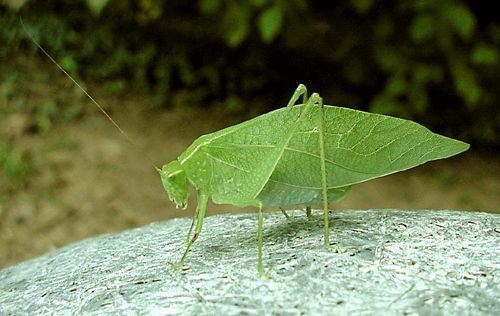
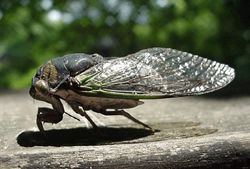 their songs were a sonorous drone all day long during the heat of July and August--which is why our most common species is called the "Dog-day Cicada" (right).
their songs were a sonorous drone all day long during the heat of July and August--which is why our most common species is called the "Dog-day Cicada" (right).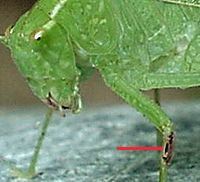 and the Bush, or False, Katydids (Phaneropterinae). It is one of the Bush Katydids (top photo) that occurs most frequently at Hilton Pond Center and raises such a ruckus on warm summer nights.
and the Bush, or False, Katydids (Phaneropterinae). It is one of the Bush Katydids (top photo) that occurs most frequently at Hilton Pond Center and raises such a ruckus on warm summer nights.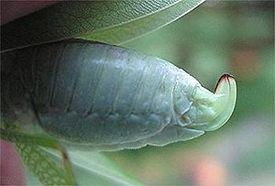 Eventually the female selects a male with a particularly pleasing (LOUD?) song, mates with him, and uses her long, scythe-shaped ovipositor (right) to make a slit in vegetation or soil into which she deposits her newly fertilized eggs. (The male's external equipment, shown below left, is called a "clasper" because it actually holds the female's abdomen in position during copulation.) At winter's end, the eggs hatch into pale, nymphal katydids that somewhat resemble the adults but lack wings and don't usually become bright green until a few molts have occurred.
Eventually the female selects a male with a particularly pleasing (LOUD?) song, mates with him, and uses her long, scythe-shaped ovipositor (right) to make a slit in vegetation or soil into which she deposits her newly fertilized eggs. (The male's external equipment, shown below left, is called a "clasper" because it actually holds the female's abdomen in position during copulation.) At winter's end, the eggs hatch into pale, nymphal katydids that somewhat resemble the adults but lack wings and don't usually become bright green until a few molts have occurred. As long-horned grasshoppers, katydids have antennae as long as or even longer than their bodies (see top photo). Most katydids are herbivorous, dining on foliage and flower petals; some also eat nectar and pollen, while a few are known carnivores that prey on other insects. All katydids are capable of biting and may do so if handled roughly. Needless to say, at Hilton Pond Center we're ever so gentle with our katydids--and our other grigs.
As long-horned grasshoppers, katydids have antennae as long as or even longer than their bodies (see top photo). Most katydids are herbivorous, dining on foliage and flower petals; some also eat nectar and pollen, while a few are known carnivores that prey on other insects. All katydids are capable of biting and may do so if handled roughly. Needless to say, at Hilton Pond Center we're ever so gentle with our katydids--and our other grigs.